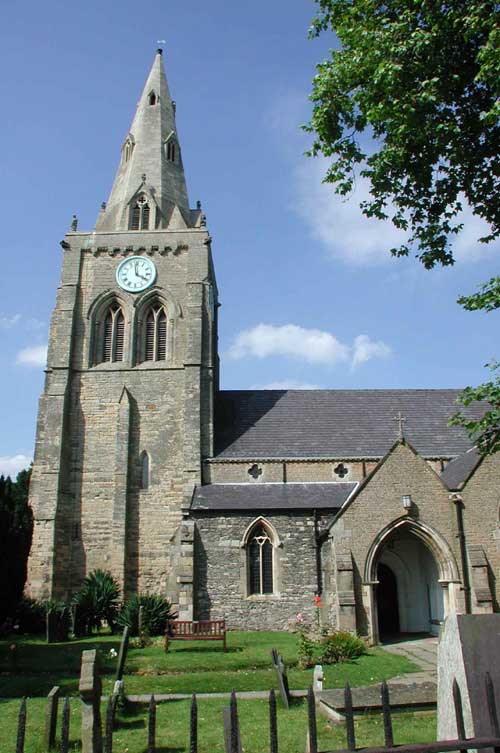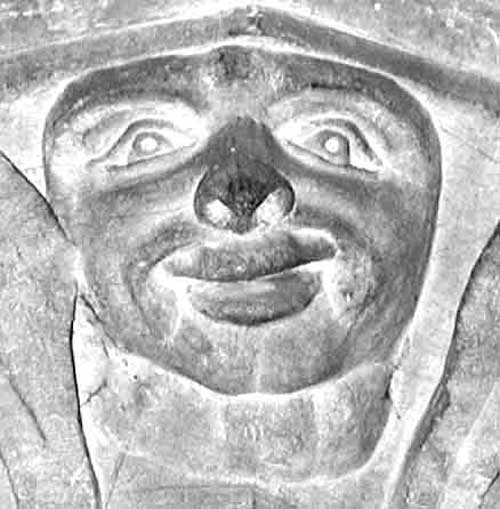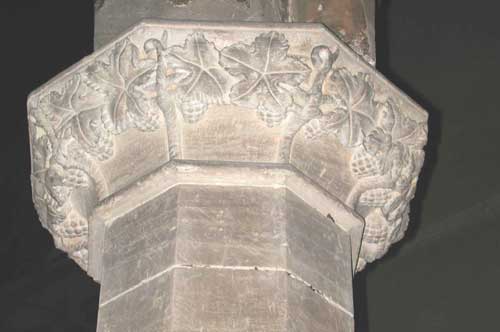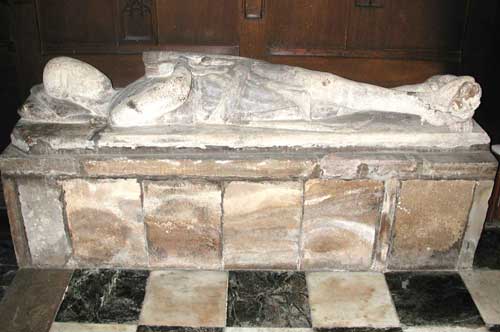![]()
BINGHAM PARISH CHURCH

The tower and nave of St Mary and All Saints' church, Bingham. Building started in 1225. (Photo: Gavin Kinsley)
St Mary’s parish church is the oldest building in Bingham, much of it being over 700 years old, although it has been constantly adapted over the centuries to reflect changing lifestyles and forms of religious worship. It probably replaced an earlier and smaller church as the surviving font is of Norman workmanship dating from the 1100s. Building of the present church began around 1220 and continued for another 75 years or so. The earliest part is the lower section of the tower with its massive one-and-a-half-metre thick walls. The rest of the tower and spire, together with the main building, seem to have been built in the late 1200s and early 1300s during the reigns of Kings Edward I and II. We can assume this from the styles of the decorative carving, which represent the changes in architectural fashion from the ‘Early English Gothic’ to the more elaborate ‘Decorated Gothic.’ Building was probably complete between by 1320.
The whole undertaking was a massive architectural and financial achievement as well as an enormous act of faith for a small community of perhaps only a hundred households with the encouragement and financial aid of the lord of the manor, Sir Richard de Bingham. Knighted by King Edward I, he served in two Parliaments and was Sheriff of Nottinghamshire and Derbyshire in 1302. He died sometime between 1308 and 1314 and his tomb is marked by the effigy of a cross-legged knight inside the chancel, carved in stone from Caen in Normandy. His widow Lady Alice and their son Sir William received a royal charter to hold the Thursday market in Bingham in 1314 (which lapsed in the 1800s but was revived in 1975). An alabaster effigy - almost certainly of Sir William, who died probably of the Black Death in 1349 – was destroyed in centuries past, with only two mutilated fragments remaining, now near the font.

Carved face on capital of a pillar in the north aisle of St Mary and All Saints' church. Early 14th century. (Photo: Gavin Kinsley
The main body of the church was built chiefly with the local rough skerry stone, but the tower has the highest quality workmanship as it is built of squared creamy-coloured stone from the famous quarries at Ancaster east of Grantham. Concealed inside the south west corner of the tower is a spiral stone staircase of 75 steps which give access to the bell-chambers. The main windows of the tower are in pairs divided by Y-shaped tracery typical of the period around 1300. Instead of glass they have ‘louvres’ or slats to allow the sound of the bells to escape.
At the top of the tower is a low parapet wall ornamented with a decorative feature known as a ‘corbel table', resembling battlements projecting downwards instead of upwards. Each downward projection is finished with a figurehead, and between them is a row of 'ball-flowers' – three-petalled flowers arranged in a ball shape - a decorative feature fashionable in the first quarter of the 1300s. The figureheads mostly represent hideous or comical faces, but some are probably portraits of real people, possibly including some of the original stonemasons. The third face from the left on the south wall is of a lady wearing a mediaeval wimple headdress, usually a symbol of widowhood. Could this be Lady Alice, widow of Sir Richard de Bingham?

Leaf-decorated octagonal capital in St Mary and All Saints' church, dated from the early 14th century. (Photo: Gavin Kinsley)
At each corner of the tower is a grotesque ‘gargoyle’ - a rainwater spout carved in the form of an ugly head. Above them in the corners of the parapet are four weathered stone pinnacles. Two take the form of human figures, apparently of a bishop and a priest. As all new building work of mediaeval churches was required to be consecrated by a bishop it is tempting to believe that these figures represent Thomas Corbridge, Archbishop of York, and possibly the church rector, Ralph de Bingham. We know that Archbishop Corbridge spent two days in Bingham on his visitation in the year 1303.The spire is supported by triangular ‘broaches’ of stone at each corner and has three sets of windows of diminishing size.
The church porch also dates from c.1300, and its large size reflects its original function as a parish meeting place where notices were read, tithes delivered to the rector, and some parts of the baptism and marriage services conducted. This is also the reason for the presence of the group of three stone seats with ‘quatrefoil’ (four petals) decoration.
Inside the church the main space – the nave – is divided into three aisles by two parallel series of pointed arches supported by pillars decorated with stone carvings on their tops. Those on the south side (nearest the porch) depict oak and vine leaves, and on that nearest the porch the mason has carved the leaves as if blown sideways by the draught from the door! Those on the north side include heads of a cow, a sheep and a pig as well as several grotesque heads of ‘scary’ devils designed to instil the fear of hellfire into the minds of non-believers.
Above these are also several carvings of human faces, which again may represent the medieval masons and prominent local worthies who helped build the church; one man with a hat looks like a merchant.

The tomb of Richard of Bingham (c. 1310) in Bingham parish church. He was Sheriff of Notts and Derbys in 1302, founded St Helen's chapel in 1301 and probably was responsible or establishing Bingham market soon after. (Photo: Gavin Kinsley)
At the same time as the parish church was being completed Sir Richard de Bingham was surprisingly also building a private manorial chapel for his own family use at the opposite end of the town (on the site of a Victorian house at the corner of Kirkhill and School Lane). In 1301 he obtained permission to found this chapel, dedicated to St. Helen, and it was licensed by the Archbishop of York in 1308. It had its own priest to say prayers for the souls of his family past and present. No trace now remains above ground but several skeletons found on the site are possibly those of Sir Richard’s family.
For further information on the parish church click here
